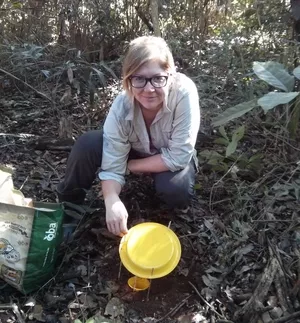Biologist Liz Nichols Part of Groundbreaking Study on Worst Places in World to Be Prey

NPR: Scientists Glued Fake Caterpillars On Plants Worldwide. Here’s What Happened.
Dozens of scientists recently glued fake green caterpillars onto plants around the world in an unusual study to see how the caterpillars' risk of getting eaten varied from pole to pole.
Any ant, slug, lizard, bird or beetle that attacked the soft clay caterpillars left telltale bite marks that were later analyzed by a lab in Finland.
It turns out the risk of being eaten was eight times higher at the equator than close to the poles, according to a newly published report in the journal Science.
"I mean, it sounds kind of like child's play, I realize," says researcher Liz Nichols of Swarthmore College. "But this kind of massive, simple, standardized technique is really powerful when you can implement it at a global scale in a really well-replicated way."
The idea for the study came when researcher Tomas Roslin at the Swedish University of Agricultural Sciences was trying to use fake caterpillars to study predation risk in Greenland. He says it's an old technique that's been around for a long time. But he wasn't having any luck — predators just weren't attacking the dummy caterpillars.
When he talked about his problem with his colleague Eleanor Slade at the University of Oxford, she told him she'd had a lot of success using them in rain forests in Borneo. The pair realized that a caterpillar's risk of being eaten might vary around the globe. And they figured they could find out by asking scientific friends, and friends of friends, to help with a little bit of fieldwork.
…
Nichols also got a box full of the fake critters, and colleagues helped her glue them on leaves at her research sites in Brazil.
Liz Nichols is an assistant professor of conservation biology. She studies biodiversity response to anthropogenic global change drivers, at scales from the individual to the biome. In particular, she is interested in understanding the influence of landscape structure on biodiversity, species interactions, ecosystem service production, and environmental sustainability. She works mainly in Brazil and the U.S. but also with partners in the U.K., Spain, and New Zealand.



